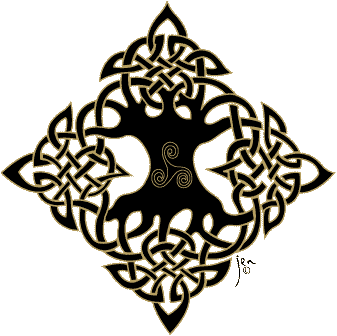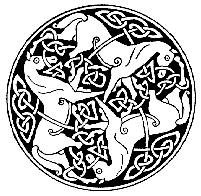The Pagan Umbrella
Celtic Traditionalism
This describes groups, clannads, whose goals
are to re-create pre-christian Gaelic religion and society. (Also refer to Reconstructional Celtic Traditions)
Witchcraft
This
describes various folk lore traditions, usually practicing low-magic and herb lore, not particulary devoted to deity specifically,
but it depends on the witch. A witch aims to reflect their life with nature. This includes Strega, Itallian, Scottish, Irish,
British Traditional Witchcraft, Hereditary witchcraft and many more, mostly being eclectic or solitare.
Wicca
Possibly
the largest branch of Paganism today, Wiccans focus on a dual and polytheistic aproach to deity and follow the cycles of the
moon and the 8 festivals of the year. The first form of Wicca was adapted by the late Gerald Gardner, rooted from Traditional
English/British Witchcraft, in 1939, which is now called Garnerian Wicca. Others, such as Alexandrian, Dianic, Seax, American
Celtic, Faery, and Correlian wicca, all have strong roots from Gardnerian, but with slightly different traditions, values,
and philosophies. A very popular form of Wicca is Eclectic or Solitary Wicca, wich was popularized by the late Scott Cunningham
in the 1980's. Many Wiccans, eclectics, prefer to practice a variety of traditions, and include other religious backgroups
into their belief system, whether it comes from monotheistic or various polytheistic and ancient traditions.
Shamanism
This
is undoubtably the oldest form of Paganism, and can be considered the oldest form of Spirituality in the world. However, this
is a very genral term, and it's roots are from indiginous tribal living, describing the spiritual teacher and healer, who
focuses on spiritual communication, animals, the earth, trances, shapeshifting, connecting with the spirits of teh earth,
divination, and healing.
Asatru
Those that practice Asatru devote themselves
to Nordic, Scandenavian, Germanic, and Icelandic deities and folk lore, and consentrate on the study of the runes of tthe
Eldar Futhark and the myths surrounding the Tree of Life, the Yggdrasil.
Druidism:
A
revival tradition attempting to recreate the Drudic system of the ancient Celts. The information used to recreate the tradition
is primarily based on myth, folklore and the very few writen records on the subject. They generally focus on Irish, welsh
and Britainic mythology and Pantheons, however many Druids do not consider it to be a religion, but a way of life. Many Druids
consider it important to learn about the trees, poems, bardic studies, herblore, and the responsibilities of those in a position
of power in society.
Santeria & Voodoo
Traditions developed among Africans,
usually a blend of their ansestrial faith and folk lore and with principles they were generally forced to practice, such as
Catholocism, once slaves in the "New World". Voodoo, for example is based in Haiti, and Santeria in Central America, Puetro
Rico and some portions of North America.
Ceremonial Magic
This involves precise rituals,
words, and tools that draw heavily on the writings of Aleister Crowley and the Hermetic Order of the Golden Dawn, Hermtica,
the Kaballah, and even the works of Solomon. Much is based on Greek, Hebrew, and some Egyptian traditions.
Mystery
Traditions
This tradition includes those who study Greek, Roman, Sumerian, and Egyptian mystery traditions, particualary
those practiced over 3000 years ago, such as "Kemetic Orthodox".
Solitare
These pagans
generally practice alone, and can be tradtionalists or eclectic.
Blended Traditions
They
blend together two paths, sometimes Paganism and a form of monothiesm, such as Judao-Pagan or Christio-Pagan, or even Buddhism


